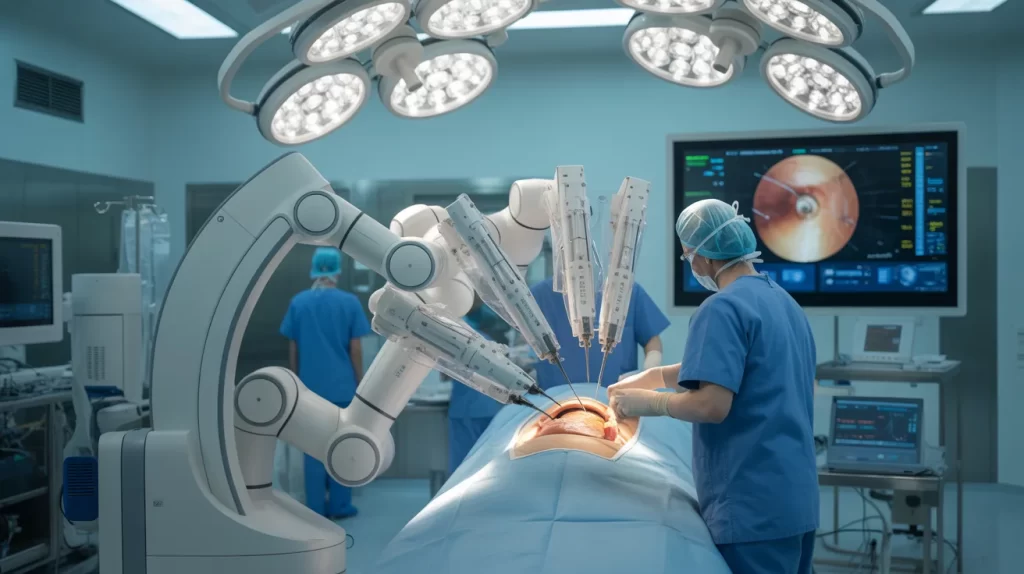Robotic knee replacement is one of the most advanced surgical options available today for treating severe knee arthritis or joint damage. It promises improved accuracy, reduced complications, and quicker recovery. However, like any medical procedure, it comes with its own set of limitations. In this blog, we will explore the key disadvantages of robotic knee replacement, when it might not be the best choice, and why choosing the Best Robotic Knee Replacement Surgeon makes all the difference.
What is Robotic Knee Replacement?
Robotic knee replacement is a surgical procedure where a robotic system assists the orthopedic surgeon during a knee replacement operation. It does not perform the surgery on its own. Instead, it enhances the surgeon’s ability to make precise cuts and align the artificial joint with exceptional accuracy.
There are different types of robotic systems, like Mako and ROSA, that offer 3D mapping and real-time feedback. These systems aim to provide better outcomes in terms of implant longevity and joint function.
Despite the many advantages, patients and caregivers should be aware of the disadvantages of robotic knee replacement, especially when making a treatment decision.

Disadvantages of Robotic Knee Replacement
Let’s take an honest look at some of the major disadvantages of robotic knee replacement:
1. Higher Cost and Limited Accessibility
- Robotic systems are expensive for hospitals to purchase and maintain.
- The cost of surgery for the patient may be higher due to the use of advanced technology.
- Not all hospitals and clinics in India, especially in smaller cities, offer robotic knee surgery.
2. Longer Surgical Setup Time
- Robotic procedures often involve additional setup, such as preoperative CT scans or intraoperative mapping.
- This may result in a longer overall surgical time compared to conventional knee replacements.
3. Steep Learning Curve for Surgeons
- Not every surgeon is fully trained or experienced in robotic-assisted techniques.
- Surgical results can vary greatly depending on the expertise of the operating surgeon.
4. Risk of Technical Malfunctions
- Like any machine, robotic systems can experience software glitches or mechanical issues.
- In rare cases, these failures can cause delays or conversion to traditional surgery.
5. Limited Suitability for Certain Patients
- Robotic knee replacement may not be ideal for patients with:
- Severe deformities
- Poor bone quality (osteoporosis)
- Excessive body weight (morbid obesity)
- These factors can limit the robot’s effectiveness and even pose surgical risks.
6. Lack of Long-Term Comparative Data
- Robotic knee replacement is a relatively new technology.
- Long-term studies comparing outcomes with conventional knee replacements are still ongoing.
- There is no definitive evidence yet that robotic-assisted procedures last longer than traditional ones.
7. Insurance and Financial Constraints
- Some insurance companies in India may not fully cover the cost of robotic-assisted surgery.
- This can make the procedure financially unviable for many patients.
Real Experiences: Patient Feedback
While many patients report excellent results, a few express concerns such as:
- Longer waiting times for surgery due to limited availability
- Confusion about the role of the robot versus the surgeon
- Frustration over higher costs without clear evidence of superiority
This is why transparent communication with your surgeon is key to setting realistic expectations.
When Robotic Knee Replacement May Not Be the Best Option
Here are situations where robotic knee surgery might not be suitable:
- Elderly patients with multiple health issues
- Patients with severely misaligned knees
- Patients seeking low-cost alternatives
- Lack of access to experienced surgeons and advanced facilities
Why Choosing the Best Robotic Knee Replacement Surgeon Matters
Even with the disadvantages of robotic knee replacement, patients can experience outstanding results when the surgery is performed by a highly trained and experienced orthopedic surgeon.
Choosing the Best Robotic Knee Replacement Surgeon ensures:
- Proper patient selection
- Skillful use of robotic systems
- Minimized surgical risks
- Customization of surgery based on patient anatomy and health
The right surgeon will also help you decide whether robotic surgery is the most appropriate choice or if a traditional knee replacement would offer better outcomes.
Alternatives to Robotic Knee Replacement
Patients have several options besides robotic surgery:
1. Traditional Total Knee Replacement
- Time-tested
- Widely available
- More affordable
2. Partial Knee Replacement
- For patients with damage in only one part of the knee
- Faster recovery
3. Non-Surgical Treatments
- Physiotherapy
- Pain management with injections or medications
- Bracing and lifestyle changes
Final Thoughts
While robotic knee surgery offers innovation and potential benefits, it’s essential to understand the disadvantages of robotic knee replacement. Cost, limited access, and technical challenges are real concerns. However, when guided by the Best Robotic Knee Replacement Surgeon, many of these disadvantages can be minimized.
Ultimately, the decision should be based on your specific condition, budget, and the expertise of your surgeon. A detailed consultation will help you choose the safest and most effective treatment for your long-term mobility and quality of life.
